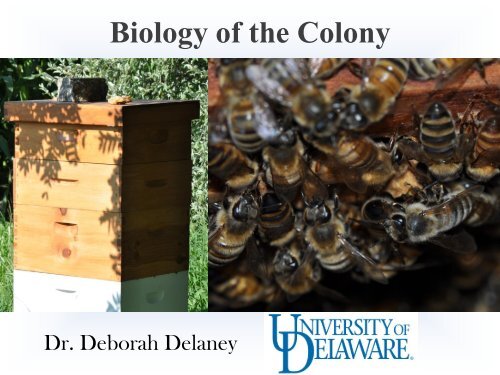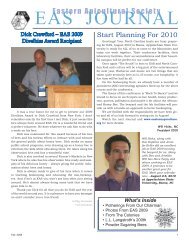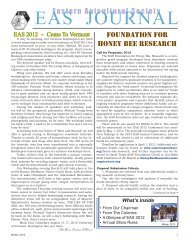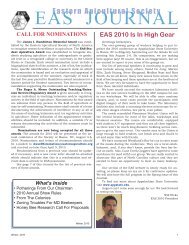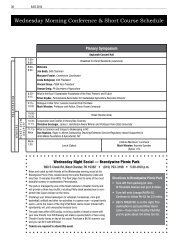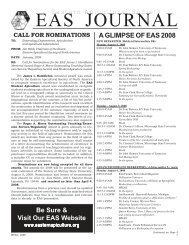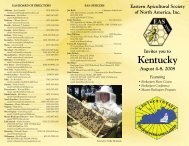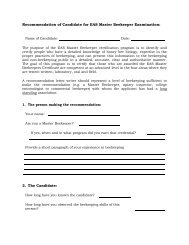Biology of the Colony
Biology of the Colony
Biology of the Colony
Create successful ePaper yourself
Turn your PDF publications into a flip-book with our unique Google optimized e-Paper software.
<strong>Biology</strong> <strong>of</strong> <strong>the</strong> <strong>Colony</strong><br />
Dr. Deborah Delaney
Eusociality<br />
Photograph © Alex Wild 2004<br />
Photograph © Alex Wild 2003
Eusocial: True Sociality<br />
Found mainly in two orders:<br />
Hymenoptera<br />
(some bees and wasps,<br />
all ants)<br />
Isoptera<br />
(all species)
Eusocial Insects<br />
Features (by definition):<br />
1. Overlap <strong>of</strong> generations<br />
2. Division <strong>of</strong> labor (Caste<br />
system) – not all<br />
individuals reproduce<br />
3. Cooperative rearing <strong>of</strong><br />
young
Eusocial Insects<br />
May also show<br />
• Trophallaxis (Ritual feeding)<br />
• Complex chemical<br />
communication (pheromones)<br />
• Nest<br />
– Often with controlled<br />
atmosphere<br />
• Specialized reproductive<br />
biology<br />
– Production <strong>of</strong> new colonies vs.<br />
production <strong>of</strong> new individuals<br />
Trophallaxis - a way <strong>of</strong> exchanging food<br />
and chemical messages<br />
• Rare (2% <strong>of</strong> species), but<br />
highly successful (some<br />
tropical areas >3/4 <strong>of</strong> biomass)<br />
Termite nests
• Some individuals<br />
reduce <strong>the</strong>ir own<br />
lifetime reproductive<br />
potential to raise <strong>the</strong><br />
<strong>of</strong>fspring <strong>of</strong> !o<strong>the</strong>rs<br />
Eusociality
How did eusociality evolve?<br />
• Mystery: not in an individual’s self interest to give up<br />
reproducing!<br />
Different <strong>the</strong>ories: Controversial<br />
Hamilton (1964): kin selection (inclusive fitness)<br />
• Haplodiploid reproduction (all Hymenoptera, also<br />
eusocial thrips)<br />
•Kin selection refers to apparent strategies in evolution that<br />
favor <strong>the</strong> reproductive success <strong>of</strong> an organism's relatives, even<br />
at a cost to <strong>the</strong>ir own survival and/or reproduction.
They’re <strong>of</strong> <strong>the</strong> same blood:<br />
The importance <strong>of</strong> relatedness<br />
• Sisters are more related to each o<strong>the</strong>r than <strong>the</strong>y<br />
are to <strong>the</strong>ir own mo<strong>the</strong>r or fa<strong>the</strong>r
How did eusociality evolve?<br />
• Group selection<br />
– Formation <strong>of</strong> a group<br />
– Persistence and cohesion <strong>of</strong> <strong>the</strong> group, defensible<br />
nest<br />
– Spreading eusocial alleles<br />
– Spreading <strong>of</strong> o<strong>the</strong>rs traits that favor <strong>the</strong> group<br />
– Natural selection acting on a group
Mechanisms <strong>of</strong> Social Organization<br />
Social organization by social insects was long<br />
held as an example by <strong>the</strong> aristocracy and<br />
various religions as a model to how human<br />
societies should be organized
Mechanisms <strong>of</strong> Social Organization<br />
Centralized<br />
• Following a leader<br />
• Using a plan, blueprint<br />
or recipe<br />
http://www.fa<strong>the</strong>rlovesaj.com/leader%20logo.jpg<br />
• Using a template or<br />
mould
Insect societies are well organized, but<br />
how do <strong>the</strong>y achieve this?<br />
Proverbs 6: 6-8- “Go to <strong>the</strong> ant thou sluggard: consider her ways, and be wise.<br />
Which having no guide, overseer <strong>of</strong> ruler, provideth her meat in <strong>the</strong> summer,<br />
and ga<strong>the</strong>reth her food in <strong>the</strong> harvest”.<br />
In insect societies no one is in charge.
Mechanism <strong>of</strong> Social Organization<br />
Self –organization or<br />
De-centralized<br />
• Global pattern <strong>of</strong> organization arises from<br />
<strong>the</strong> interactions <strong>of</strong> many individuals whom<br />
follow simple rules in response to local<br />
conditions. No one individual is in charge.<br />
• Ex: cells in a multicellular organism,<br />
grains <strong>of</strong> sand in a sand dune, social insect<br />
colonies
Activity
In what ways can<br />
sociality benefit<br />
insects?<br />
Margy Nelson
Insect sociality<br />
• Benefits <strong>of</strong> sociality:<br />
– Utilization <strong>of</strong> large and more diverse resources<br />
– Group defense against predators<br />
– Existence as perennial, long-lived organisms
“Super-organism”<br />
• Intake resources<br />
• Waste disposal<br />
• Defense<br />
• Reproduction<br />
• Environmental control<br />
They use social design to solve ecological problems normally<br />
faced by single organisms- origin <strong>of</strong> <strong>the</strong> concept <strong>of</strong> “superorganism”
Who are <strong>the</strong> bees<br />
in your colony?
Sex determination<br />
X<br />
X<br />
Unfertilized eggs<br />
1n<br />
1n<br />
Fertilized eggs<br />
X<br />
2n<br />
2n<br />
2n<br />
Fertilized eggs<br />
2n
Sex Determination<br />
• If an egg is heterozygous at <strong>the</strong><br />
sex loci= Become a female<br />
• If an egg is homozygous at <strong>the</strong><br />
sex loci <strong>the</strong> individual will be a<br />
diploid drone<br />
• If <strong>the</strong> egg is unfertilized<br />
(<strong>the</strong>refore haploid) <strong>the</strong><br />
individual will become a viable<br />
haploid drone
Basic <strong>Biology</strong><br />
Mating genetics<br />
=<br />
Leads<br />
to a number <strong>of</strong><br />
subfamilies in <strong>the</strong> colony<br />
(actually about 17 drones)<br />
Sperma<strong>the</strong>ca full <strong>of</strong> stored sperm<br />
(actually 4-7 million sperm)
Basic <strong>Biology</strong><br />
<strong>Colony</strong> genetics<br />
Leads to a number <strong>of</strong><br />
subfamilies in <strong>the</strong> colony<br />
1<br />
3<br />
2<br />
6<br />
6 subfamilies<br />
present in this<br />
hive<br />
4<br />
5<br />
2<br />
1
Haplodiploidy<br />
• Haplodiploidy: Viable drones come from<br />
unfertilized eggs, females from fertilized eggs
<strong>Biology</strong> <strong>of</strong> <strong>the</strong> <strong>Colony</strong>
Swarming
<strong>Colony</strong> fission: natural swarming<br />
Splitting is managerially equivalent to swarming:<br />
<strong>the</strong> natural process by which colonies reproduce<br />
~50% workers<br />
& parental queen<br />
• Swarming has been shown as an acquired evolutionary technique that reduces pests<br />
and diseases within honey bee populations<br />
• Occurs in mid to late spring when bee populations are high and flowering is more intense
A Cavity nester<br />
• Location dependent on<br />
amount <strong>of</strong> available<br />
cavities and <strong>the</strong> ability to<br />
<strong>the</strong>rmoregulate<br />
Photo Joseph Nicolay
Thermoregulation
Current Apis species distribution
Pollination<br />
Bee-dependent crops account for $47.1<br />
billion every year, <strong>of</strong> which $14.6 billion<br />
is attributable to honey bee pollination
Communication<br />
• Honey bees are eusocial<br />
• Pr<strong>of</strong> von Frisch<br />
discovered <strong>the</strong>ir<br />
communication basics<br />
• A bee discovers a food<br />
source….<br />
she returns home to tell<br />
her sisters<br />
where it is, how far, &<br />
how good !
Round Dance<br />
Quick short steps<br />
in narrow circles<br />
On beeswax comb<br />
Food close<br />
Odor & taste clues<br />
Richness clues
Wagtail Dance<br />
Bee makes ½<br />
circle, straight<br />
run while waggling<br />
Abdomen <strong>the</strong>n ½<br />
circle again<br />
Distance<br />
Direction<br />
Odor & taste clues<br />
Richness clues
From Gould & Gould 1988<br />
Wagtail Dance
• The number <strong>of</strong><br />
dancing bees and<br />
<strong>the</strong> frequency <strong>of</strong><br />
dance can relay<br />
quality and<br />
quantity <strong>of</strong><br />
resource<br />
Taste and smell
• Different subspecies<br />
have different<br />
variations <strong>of</strong> <strong>the</strong><br />
dance<br />
• Different dances for<br />
different distances<br />
• Different subspecies<br />
have trouble<br />
communicating<br />
location to one<br />
ano<strong>the</strong>r<br />
Dialects
<strong>Colony</strong> Communication
Pheromones <strong>of</strong> <strong>the</strong> Queen Honey Bee<br />
Pheromone<br />
Queen substance (QMP)<br />
Foot-print pheromone<br />
Tergal pheromone<br />
(abdominal)<br />
Feces pheromone<br />
Egg marking pheromone<br />
Queen attractant scent<br />
Queen cell pheromone<br />
Source<br />
mandibular glands<br />
Arnhart (tarsal) glands<br />
Tergite glands<br />
Hindgut<br />
Dufor’s gland?<br />
Koschevnikov gland<br />
immature queen / cell
Queen Substance<br />
Source: Mandibular glands<br />
Primary component:<br />
9-oxo-trans-2-decenoic acid<br />
Mixture <strong>of</strong> 5 compounds; blend important
• Virgins and mated<br />
queens have different<br />
QMP pr<strong>of</strong>iles<br />
QMP
• Queens with more<br />
mates have more<br />
attractive QMP pr<strong>of</strong>ile<br />
QMP
Queen Substance Dispersal<br />
Queen pheromone
Retinue Formation<br />
• Mandibular gland<br />
pheromone complex<br />
– Mixture important,<br />
single components do<br />
not have activity
Queen Inhibition <strong>of</strong> Queen Rearing<br />
• Queen mandibular gland complex- major<br />
inhibitor (exception)<br />
• Additional pheromone from tergite glands may<br />
help suppress queen rearing<br />
• Possible “fecundity” signal from young brood
Inhibition <strong>of</strong> rearing replacement queens
Sex attraction
Swarm Stabilization
Stimulation <strong>of</strong> foraging/brood rearing<br />
R. Williamson photo
Participates in suppression <strong>of</strong> worker<br />
ovaries<br />
Queen<br />
Worker
Egg Pheromone<br />
o Queen produced<br />
Function: discrimination <strong>of</strong><br />
queen-laid versus workerlaid<br />
eggs<br />
Aid to worker policing <strong>of</strong><br />
worker-laid eggs
Queen Cell Pheromone<br />
Present on queen pupae:<br />
methyl linoleate, methyl<br />
linolenate, methyl oleate<br />
Functions:<br />
• Recognition <strong>of</strong> queen cells<br />
• Serve as part <strong>of</strong> a feed-back<br />
control system governing <strong>the</strong><br />
production <strong>of</strong> queen cells
Worker Pheromones<br />
• Orientation<br />
– nasonov gland<br />
scenting<br />
R. Williamson photo<br />
Mixture <strong>of</strong> 7 terpenoids: E- & Z- citral, nerol, nerolic acid,<br />
geraniol, geranic acid & farnesol
Worker pheromones<br />
• Orientation<br />
• Alarm<br />
– worker mandibular gland<br />
• 2 heptanone<br />
– worker sting gland<br />
• Iso-pentyl acetate
Worker Pheromones<br />
• Orientation<br />
• Alarm<br />
• Trail pheromone<br />
• Brood pheromone<br />
• Beeswax comb<br />
• o<strong>the</strong>rs
Guard bee<br />
Hive Odor
Age based polyethism
Division <strong>of</strong> Labor in Worker Bees
<strong>Colony</strong> Requirements<br />
• Nectar<br />
• Pollen<br />
• Water<br />
• propolis
From Nectar to Honey
From Nectar to Honey<br />
• Nectar is 80% water,<br />
whereas honey is only<br />
19% water<br />
• To make 1 pound <strong>of</strong><br />
honey, a colony <strong>of</strong> bees<br />
collects nectar from over<br />
1 million flowers


